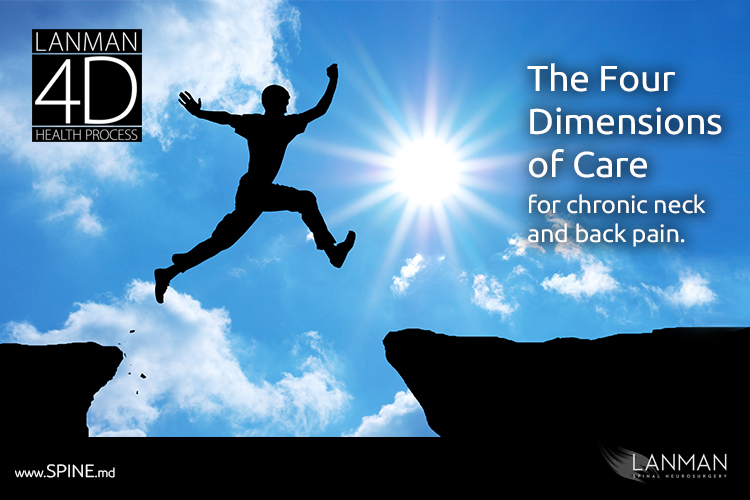Patients who need to see a doctor, want to “get better.” In my case, if a patient is suffering chronic pain in their neck or back, they probably want to see a neurosurgeon who specializes in treating disorders of the spine. For them, healing and being “better” means that they want to be pain-free. But what if we can heal them to be better than that? If I have anything to do with their treatment, I will do whatever I can to preserve as much of their natural range of motion as possible.
A patient came to see me not long ago who recently had cervical (neck) spinal fusion. That’s not so unusual at my practice in Beverly Hills, CA and from the patients I see from the Cedars-Sinai Institute of Spinal Disorders. Her problem was that despite several visits to her surgeon, she still suffered nerve pain in her neck.
The story she imparted to me was that each time she saw the surgeon, he said three things: one, she had a herniated disc; two, the fusion looked good; three, she probably needs another fusion. She said that it was like watching someone solving a Rubik’s cube where all the sides were the same color. Out of frustration, she asked for a second opinion. I spent about an hour with her going over her habits, hobbies, history, and came away with a few hunches. An MRI scan confirmed an undiagnosed stenosis in an adjoining level. I performed a micro-decompression, and the patient is currently living pain-free. I advised her that she may need additional surgery in the future – but no more fusions.
Unfortunately, this is typical of these kinds of cases. When doctors spend so little time discussing a patient’s case – if you apply the same diagnosis template case after case – something will be missed.
It’s ironic that economics is the impetus for doctors to avoid spending “too much time” with a patient. Considering the increased incidence of patients who claim they’ve been diagnosed with “failed back surgery syndrome” (FBSS), apparently spending less time with patients costs more for everyone.
Spending less time causes the patient to wait longer for a treatment solution that solves the problem. Waiting longer encourages the process of degeneration and increases the likelihood that a case will become so severe that treatment options are limited.
For instance, minimally invasive surgical techniques require intervention at the earliest possible time. If the patient is limping into the office in excruciating pain, it is more likely that the treatment solution will include far more invasive intervention that results in greater post-surgical treatment and healing.
My 25 years of experience as a spinal neurosurgeon has taught me that spinal disorders require a more considerable investment from me to solve each patient case. That’s why my work begins with what I call the “four dimensions of health.”
The first dimension is “Discussion.”
We’re all living longer. But as we live longer, we also tend to want to be more active. If you’ve had previous athletic experience in your life, there’s a higher likelihood that you’ll re-engage later in life. Along with that trend comes a higher risk for joint degeneration or injury. In this case, we’re primarily concerned with the health and fitness of your spine. Your spine is the center of everything: motion, balance, functionality. It’s also the primary location for the most common problems. Along with chronic pain, we can have neurological weakness, numbness, tingling in the arms and legs that can disable us and prevent us from enjoying and experiencing life to its full potential.
Patients usually see a doctor long after pain and disability have begun to affect their health and quality of life negatively. The only way I’m ever going to discover what’s causing your problems is through active listening and a willingness to spend as much time as necessary to have a complete understanding of the case.
The second dimension is “Diagnosis.”
Here I point to my years of experience as a professor at the University of California Los Angeles, and a member of the Cedars-Sinai Institute of Spinal Disorders. Time and again I see cases that remind me that every diagnosis is unique to the patient and their circumstances. Indeed, there are similar outcomes – vis-à-vis treatment solution. However, the differences only begin with the physiology of the case and how the condition impacts the body.
Every diagnosis should take into consideration future problems. Where the spine is concerned, we must plan ahead. The patient does not to merely want to “get better” – they want to become “greater than better.”
The third dimension is “Action.”
There are four major types of surgery you can have to relieve neck and back pain: laminectomy, discectomy, spinal fusion, and artificial disc replacement. However, my approach for the treatment of spinal disorders is to weigh all possible actions – not just surgical.
There are also options like physical therapy. But I may recommend actions that can help strengthen the body and reduce inflammation from the inside out – nutrition, fitness, body chemistry and supplements. I may also recommend asymptotic disease screening and pain management. Just as each diagnosis is unique, every action is exclusive to the case and the patient.
The fourth dimension is “Time.”
Consider how the system causes us to wait before we see a doctor. We may allow a condition to grow so acute that we’re doubled over in agony as we stagger into the doctor’s office.
In the case of my patient, her primary care physician prescribed pain medication for a partially herniated disc. She lived like that for a while until the disc completely collapsed and the pain became unmanageable. That’s what led to her surgeons’ recommendation for spinal fusion surgery. What I would call the “end game” for spinal treatment, became her “go-to.” I would have prescribed a partial microdiscectomy. With some physical therapy and a fitness and nutrition program, she might have delayed further surgery for a few years – or indefinitely.
When I reach back to diagnosis and action, I plan for time: time to heal, time to recover, time for possible resurgery or additional actions. As part of this calculus, I see spinal fusion as the end-game because we end the pain by ending motion. There’s nothing else after fusion. But if I weigh time as I reach for a diagnosis, then the course of action becomes holistic: preserving natural range of motion longer with incremental treatments like microlaminectomy-discectomy or artificial disc replacement. Or what if I can avoid surgery altogether?
Some people wait because they want to. They have their reasons. But keep in mind that people who have a successful spine surgery don’t often brag about it. Instead, they’re out there, enjoying their lives with a full range of motion. The fact is, the most successful patients work ahead of their problems, identify early issues with their doctors, and become proactive in maintaining their health. And that takes time.







